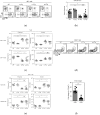The Potential Role of a Soluble γ-Chain Cytokine Receptor as a Regulator of IL-7-Induced Lymphoproliferative Disorders
- PMID: 30373315
- PMCID: PMC6274946
- DOI: 10.3390/ijms19113375
The Potential Role of a Soluble γ-Chain Cytokine Receptor as a Regulator of IL-7-Induced Lymphoproliferative Disorders
Abstract
IL-7 is an essential, nonredundant growth factor for T and B cell generation and maintenance. While IL-7 deficiency results in lymphopenia, overexpression of IL-7 can cause neoplasia in experimental models. IL-7's involvement in neoplasia has been appreciated through studies of IL-7 transgenic (Tg) mice models and human lymphoma patients. Since we recently found that a soluble form of the common γ-chain (γc) cytokine receptor (sγc) antagonistically regulates IL-7 signaling, IL-7 and sγc double-Tg mice were generated to investigate the effects of sγc overexpression in IL-7-mediated lymphoproliferative disorders (LPDs). The overexpression of sγc prevents IL-7Tg-induced abnormal increase of LN cell numbers and the development of splenomegaly, resulting in striking amelioration of mortality and disease development. These results suggest that modification of γc cytokine responsiveness by sγc molecules might control various γc cytokine-associated hematologic malignancy, and also provide an alternative view to approach antitumor therapy.
Keywords: IL-7; cytokine; lymphoma; sγc.
Conflict of interest statement
The authors declare no conflict of interest.
Figures




References
-
- Touw I., Pouwels K., van Agthoven T., van Gurp R., Budel L., Hoogerbrugge H., Delwel R., Goodwin R., Namen A., Lowenberg B. Interleukin-7 is a growth factor of precursor B and T acute lymphoblastic leukemia. Blood. 1990;75:2097–2101. - PubMed
MeSH terms
Substances
Grants and funding
LinkOut - more resources
Full Text Sources
Miscellaneous

